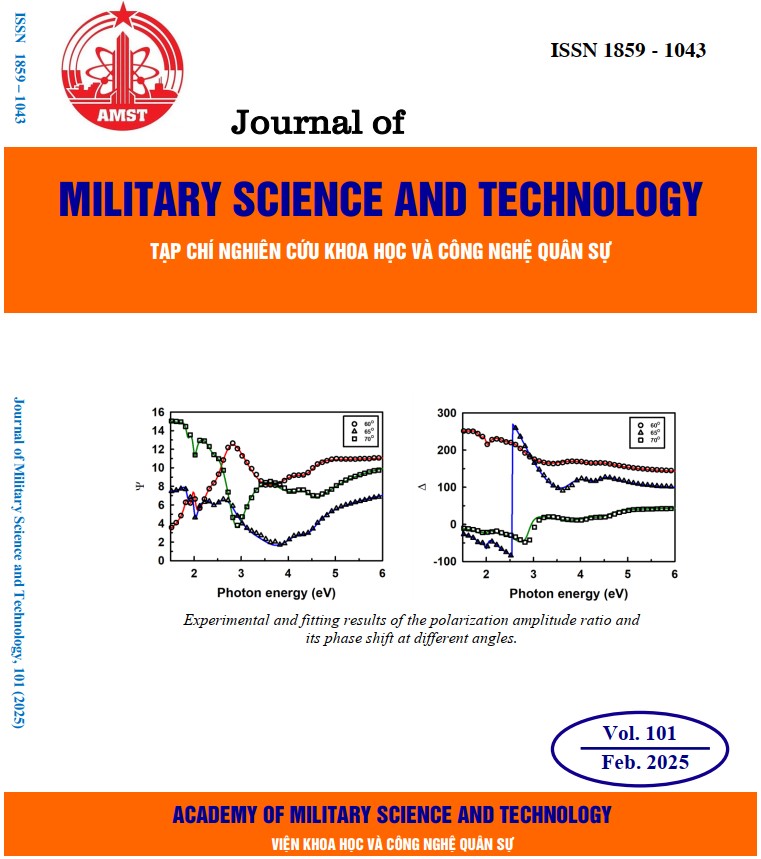Nghiên cứu chế tạo vật liệu khung cơ kim MIL-101(Cr) và khả năng xúc tác quang của vật liệu để xử lý Nitrat trong nước
623 lượt xemDOI:
https://doi.org/10.54939/1859-1043.j.mst.101.2025.102-109Từ khóa:
MOF; MIL-101; Hiệu suất xử lý nitrat; Tác nhân loại bỏ lỗ.Tóm tắt
Bài báo này trình bày kết quả nghiên cứu một số đặc trưng của vật liệu khung cơ kim MIL-101(Cr) và khả năng xử lý nitrat trong môi trường nước của vật liệu trên cơ sở phản ứng xúc tác quang. Vật liệu này được chế tạo bằng phương pháp thủy nhiệt trong phòng thí nghiệm và các kỹ thuật FE-SEM, XRD, FT-IR, BET đã được sử dụng cho thấy cấu trúc xốp của vật liệu rất phát triển, diện tích bề mặt riêng lên đến 3017 m2/g, kích thước tinh thể bát diện đặc trưng với kích thước hạt khoảng 100 - 300 nm. Kết quả thí nghiệm cho thấy trong điều kiện ánh sáng đèn UV bước sóng 365 nm, công suất 250 W, MOF MIL-101(Cr) có khả năng xúc tác xử lý nitrat dưới ánh sáng đèn UV bước sóng 365 nm, công suất 250 W với hiệu suất xử lý cao nhất lên đến 99% sau 180 phút phản ứng. Hiệu suất xử lý nitrat của MIL-101 đạt gần 100% trong thời gian phản ứng là 40 phút khi xuất hiện tác nhân axit fomic (HCOOH 46 mM).
Tài liệu tham khảo
[1]. E. Bowles, M. Burleigh, A. Mira, S. Van Breda, E. Weitzberg, and B. Rosier, "Nitrate:“the source makes the poison”," Crit. Rev. Food Sci. Nutr., 1-27, (2024). DOI: https://doi.org/10.1080/10408398.2024.2395488
[2]. F. Rezvani, M.-H. Sarrafzadeh, S. Ebrahimi, and H.-M. Oh, "Nitrate removal from drinking water with a focus on biological methods: a review," Environ. Sci. Pollut. Res. 26, 1124-1141, (2019). DOI: https://doi.org/10.1007/s11356-017-9185-0
[3]. A.P. Varghese, and S.K. Lakhera, "Comprehensive analysis of catalysts, reaction mechanisms, and efficiency factors in photocatalytic nitrate-to-ammonia conversion," Renew. Sustain. Energy Rev. 200, 114537, (2024). DOI: https://doi.org/10.1016/j.rser.2024.114537
[4]. S. He, L. Wu, X. Li, H. Sun, T. Xiong, J. Liu, C. Huang, H. Xu, H. Sun, and W. Chen, "Metal-organic frameworks for advanced drug delivery," Acta Pharm. Sin. B. 11, 2362-2395, (2021). DOI: https://doi.org/10.1016/j.apsb.2021.03.019
[5]. F. Zheng, W. Zhang, Q. Guo, B. Yu, D. Wang, W. Chen, "Metal clusters confined in porous nanostructures: Synthesis, properties and applications in energy catalysis," Coord. Chem. Rev. 502, 215603, (2024). DOI: https://doi.org/10.1016/j.ccr.2023.215603
[6]. Z. Wang, C. Wang, Q. Hu, X. Lei, R. Guo, J. You, Y. Tian, F. Yang, and M. Lv, "Covalent-metal organic frameworks: preparation and applications," Chem. Eng. J., 149217, (2024). DOI: https://doi.org/10.1016/j.cej.2024.149217
[7]. J. Cao, Y. Li, M. Qi, X. Ma, F. He, Y. Wang, and D. Zhao, "Engineering porosity of MIL-101 (Cr) using solvation effect," J. Environ. Chem. Eng. 12, 112753, (2024). DOI: https://doi.org/10.1016/j.jece.2024.112753
[8]. T.H. Dolla, B. Zhang, T. Matthews, M.P. Chabalala, S.O. Ajayi, L.L. Sikeyi, X. Liu, and M.K. Mathe, "Metal/covalent-organic framework-based electrocatalysts for electrochemical reduction of nitrate to ammonia," Coord. Chem. Rev. 518, 216061, (2024). DOI: https://doi.org/10.1016/j.ccr.2024.216061
[9]. X. Yang, X. Qi, G. Ma, Z. Li, Q. Liu, S. Khan, Y. Zhao, L. Zhang, Z. Geng, and Y. Guo, "Novel Z-Scheme Ag/TiO2/AgMIL-101 (Cr) as an efficient photocatalyst for nitrogen production from nitrate," Appl. Surf. Sci. 479, 1048-1056, (2019). DOI: https://doi.org/10.1016/j.apsusc.2019.02.111
[10]. A. Augustin, P. Ganguly, S. Shenoy, C. Chuaicham, S.C. Pillai, K. Sasaki, A.F. Lee, and K. Sekar, "Impact of hole scavengers on efficient photocatalytic hydrogen production," Adv. Sustain. Syst., 2400321, (2024). DOI: https://doi.org/10.1002/adsu.202400321
[11]. J. A. Zazo, P. García-Muñoz, G. Pliego, J. E. Silveira, P. Jaffe, and J. A. Casas, "Selective reduction of nitrate to N2 using ilmenite as a low cost photo-catalyst," Appl. Catal. B. 273, 118930, (2020). DOI: https://doi.org/10.1016/j.apcatb.2020.118930
[12]. J. Xie, R. Wang, Z. Ni, Y. Li, S. Ye, and X. Song, "The visible light photocatalytic degradation of ethylene using a polyvinyl alcohol film loaded with Ag2O-TiO2-Bi2WO6 heterojunction microspheres," Appl. Surf. Sci. 584, 152562, (2022). DOI: https://doi.org/10.1016/j.apsusc.2022.152562
[13]. N. Cherupurakal, R. Krishnapriya, A. Bojarajan, T. Ramachandran, S. Sangaraju, M.S. Mozumder, and A.-H.I. Mourad, "Enhanced electrochemical validation of metal organic frameworks-derived TiO2/Fe-TiO2 as an active electrode for supercapacitors," Mater. Renew. Sustain. Energy. 1-13, (2024). DOI: https://doi.org/10.1007/s40243-024-00269-4
[14]. Z. Geng, Z. Chen, Z. Li, X. Qi, X. Yang, W. Fan, Y. Guo, L. Zhang, and M.J.D.T. Huo, "Enhanced photocatalytic conversion and selectivity of nitrate reduction to nitrogen over AgCl/TiO2 nanotubes," 47, 11104-11112, (2018). DOI: https://doi.org/10.1039/C8DT01915K
[15]. R. Wang, M. Yue, R. Cong, W. Gao, T.J.J.o.A. Yang, and Compounds, "Photocatalytic reduction of nitrate over chalcopyrite CuFe0.7Cr0.3S2 with high N2 selectivity," 651, 731-736, (2015). DOI: https://doi.org/10.1016/j.jallcom.2015.08.182
[16]. H. Adamu, M. Shand, R.S. Taylor, H.G. Manyar, and J.A. Anderson, "Use of carbon-based composites to enhance performance of TiO2 for the simultaneous removal of nitrates and organics from aqueous environments," Environ Sci Pollut Res Int. 25, 32001-32014, (2018). DOI: https://doi.org/10.1007/s11356-018-3120-x







